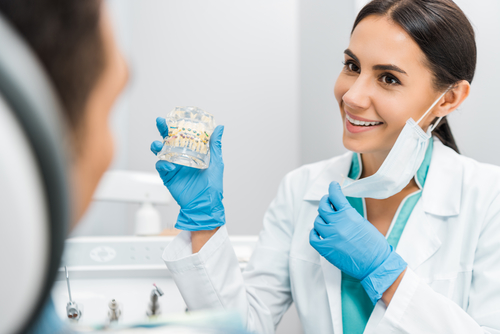
Deciding to pursue orthodontic treatment for your child or yourself is one of the best decisions you could ever make. Initial consultations can be overwhelming if you are unfamiliar with the orthodontic terminology used during your appointment. Below is a list of several common terms used in orthodontics today.
Appliances
Any device, attached to the teeth or removable, designed to move the teeth, change the position of the jaw or hold the teeth in their finished positions after braces are removed.
Archwire
The archwires are the metal wires that go through all of the bands and brackets of braces and guide the teeth into their new positions. In most cases, you will have an upper archwire and a lower archwire. Some of your orthodontist appointments might be for a new archwire, which means you will be getting a tighter wire to help continue the movement of the teeth.
Band (Orthodontic)
Bands are thin stainless steel metal rings that are cemented typically to the back teeth (the molars) where biting forces are stronger. They are more durable than brackets and do not come loose as readily.
Bracket
Brackets are the small metal or ceramic modules attached to each tooth. They serve as guides to move the teeth and hold the archwire in place. The brackets used in orthodontics today bond directly to the teeth with a tooth-colored bonding adhesive.
Elastic Rubber Bands
During various phases of treatment, small elastic or rubber bands are used as a gentle but continuous force to help individual tooth movement or the aligning of jaws.
Fixed Appliances
An orthodontic appliance that is bonded or cemented to the teeth and cannot be or should not be removed by the patient.
Headgear
A common orthodontic appliance that applies extraoral traction for growth modification, tooth movement, and anchorage. Headgears and neck gears typically are composed of a stainless steel wire (a facebow) that inserts into metal tubes attached to metal bands on the upper first molars within the mouth. The facebow extends out of the mouth where a thick elastic strap connects to the facebow and applies a light force backward to help correct an overbite for example.
Herbst Appliance
This appliance is used to move the lower jaw forward. It can be fixed or removable. When it is fixed, it is cemented to teeth in one or both arches using stainless steel crowns. An expansion screw may be used simultaneously to widen the upper jaw.
Ligature Ties
These are similar to elastic ties, but they are made of stainless steel, and they are used to secure the archwire more snugly to the bracket. There is a twisted end to these ligatures that can sometimes bend outward and cause irritation, so use a pencil eraser to bend it back inward if this occurs.
Overbite
Vertical overlapping of upper teeth over lower teeth usually measured perpendicular to the occlusal plane.
Palatal Expander
An appliance used to help widen your upper jaw or palate.
Removable Retainer
An appliance that the orthodontist gives you to wear after your braces are removed. The retainer attaches to your upper and or lower teeth and holds them in the correct position while the bone around your teeth adjusts to the new positions of your teeth. At first, you wear the retainer 24 hours a day, and then only at night.
Rubber Bands
During certain stages of treatment, small elastics or rubber bands are worn to provide individual tooth movement or jaw alignment.
Separators
An elastic o-ring or small wire loop placed between the teeth to create space for placement of bands. Separators are usually placed between the teeth a week before bands are scheduled to be cemented to the teeth.
Space Maintainer
A fixed appliance used to hold space for an unerupted permanent tooth after a primary (baby) tooth has been lost prematurely, due to accident or decay.
Tongue Crib
A fixed appliance used to help a patient stop habits, or undesirable tongue forces exerted on the teeth and bone that supports the teeth.
Wax
A clear wax used to prevent your braces for irritating your lips when your braces are first put on, or at any time irritation occurs.
Still Have Terminology Uncertainty?
Whether you are new to braces for kids or adults, or already in full treatment, it never hurts to be informed. Having a better understanding of some of the terms, you might hear at your visits to the orthodontist will give you complete confidence throughout treatment. If you’re unsure of what a word means during a visit, just ask Dr. Thomas! We always want our patients and our parents to feel comfortable in asking us anything at Thomas Orthodontics.





